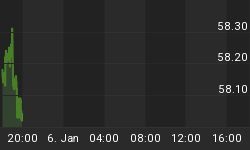Below are extracts from a commentary posted at Silver and Inflation/Deflation An extremely bullish supply/demand picture can be painted for silver. However, while there is little doubt that for many years the amount of newly-mined silver has been less than the amount of silver consumed it should be noted that any analysis of silver's overall supply situation is based on assumptions, which may or may not be correct, regarding the amount of silver in storage throughout the world. There is also no way of knowing how much silver will be 'dishoarded' by private Indian investors in response to a price rise. In our opinion, therefore, silver's true supply/demand situation is unknown. The silver price has moved sharply higher since the middle of last year, but in this respect it has performed in line with most of the other industrial metals. Furthermore, we don't see a reason why silver will suddenly start moving in the opposite direction to the industrial metals so when the metals complex corrects later this year -- we expect the other industrial metals to peak quite soon (by May at the latest) and then pullback for 1-2 quarters before resuming their upward march -- silver should also correct. There is a monetary component to silver's overall demand as well as an industrial component and for this reason silver will probably hold-up better than copper and some of the other economically-sensitive metals during the coming correction (a correction that we expect will roughly coincide with a downturn in the stock markets of the world and in global economic growth). In any case, once global growth expectations begin being ramped downward gold should start to handily out-perform ALL the other high-profile metals, just as it did between late 2000 and early 2003. As an aside, in the current environment a downturn in global economic growth will NOT have deflationary consequences. On the contrary, if it happens it will have inflationary consequences. Here's why: The argument for deflation revolves around the enormous existing debt levels, but under the current monetary system it is this debt that all but guarantees there will be nothing other than inflation as far as the eye can see. This is because the debt dramatically increases the short-term adverse consequences of deflation, removing deflation as a political option. On the other hand, if debt levels were considerably lower then some deflation would be permissible in order to stifle the surges in commodity and asset prices. But, the deflationists argue, the debt levels are so high that the Fed will be powerless to stop the impending deflation. This argument is false, though, because the Fed's power to create currency is unlimited. For example, the total amount of debt in the US economy is presently 35 trillion dollars, give or take a trillion or two, but if the Fed chose to do so it could monetise $35T of debt tomorrow. Obviously, the Fed would absolutely not want to take such drastic action because doing so would render the US$ worthless. It's plan, instead, will be to facilitate enough inflation at any time to keep things rolling along but not so much that there will be a collapse in confidence.
To argue that the US faces a serious near-term deflation threat is therefore to argue that the Fed will choose not to make full use of its powers; and this argument flies in the face of 70 years of evidence. So, when the economic data takes a decisive turn for the worse over the coming months and deflation once again becomes a hot topic in the financial media, don't focus on the perceived deflation threat; focus on the policy response to this threat.
Getting back to silver, we've observed that support and resistance levels tend to have less influence in the silver market than they do in, for example, the gold and currency markets, making technical analysis of the silver market more problematic. However, the below long-term weekly chart of silver futures paints a picture of a bull market, albeit one that appears to be very extended in the short-term. Our guess is that silver will peak at around $7.50 and then spend about 6 months consolidating in the $5.80-$7.00 range before resuming its ascent.

Gold and Bonds
Since the final quarter of 2000 the T-Bond price has surged for 4-5 months following each intermediate-term peak in the gold price. The below chart comparison of bonds and gold illustrates this behaviour.

There are three things we think are worth taking away from the above chart:
Firstly, the surge in the bond price over the past two months marks the January high in the gold price as an intermediate-term peak.
Secondly, if the pattern of the past three years repeats then the next intermediate-term peak in the bond market is not going to occur until May or June.
Thirdly and most importantly, the trends of the past few years appear to be intact. The implication, here, is that although the January peak in the gold market was probably of the intermediate-term variety, it most likely was NOT the ultimate high for the current leg in the gold bull market.
Now, we've previously discussed the possibility that gold will make a peak of equivalent importance to its December-1974 peak during the first half of this year. That might still be the case, but we doubt that such a peak is already in place. Instead, the markets seem to be repeating the pattern of the past few years and one characteristic of this pattern has been progressively higher intermediate-term peaks and troughs for the gold price. Therefore, even if gold has seen its peak for the first half of 2004 it should move well above its January high before the year is out.















